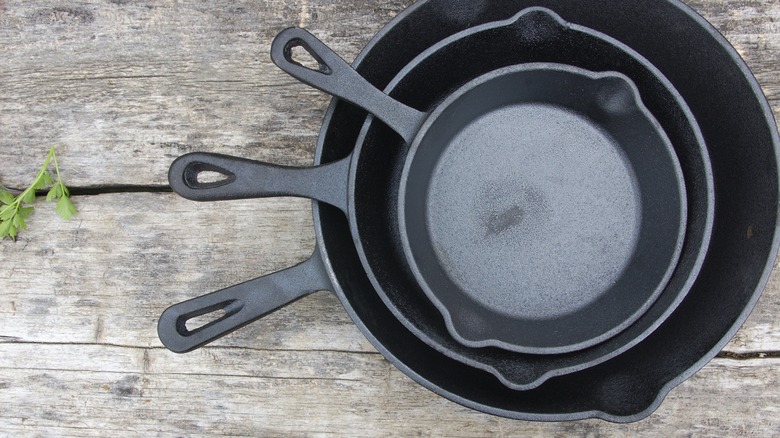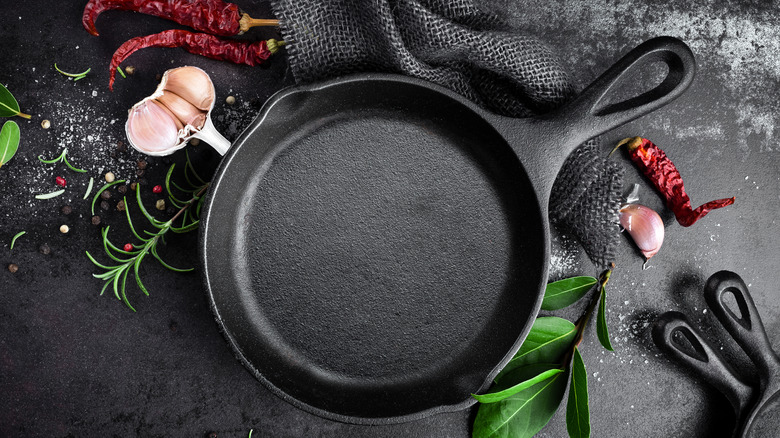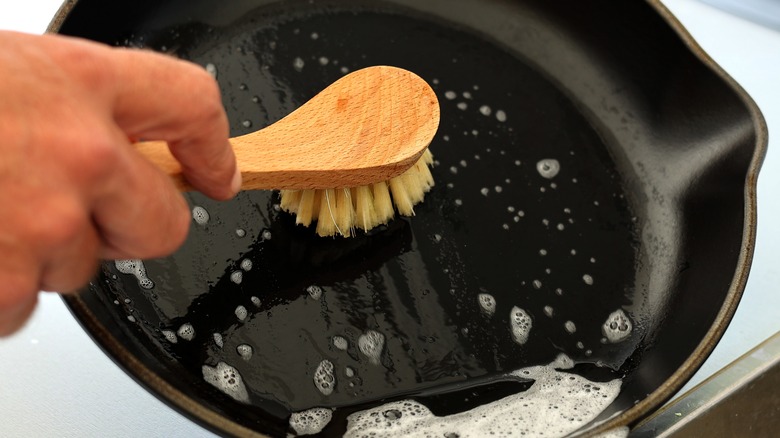Why Your Cast Iron Pan Is Sticky, And How To Fix It
For centuries, cast iron pans have remained a staple in many home kitchens — and for good reason. Their sturdiness, along with their ability to distribute and retain heat evenly for extended periods, has allowed them to rival even the newest pots and pans available for sale. But while some people have a personal attachment to their cast iron skillets, many home cooks are intimidated by the upkeep behind these pieces of cookware. For example, what happens if your cast iron skillet gets sticky? How do you fix it? Thankfully, it's a relatively easy problem to deal with.
Most of the time, stickiness on the surface of your pan means that it's been overseasoned. Oil slowly accumulates on cast iron, and too much of it can cause it to cake, creating a gummy texture that ruins the nonstick properties of a well-seasoned skillet. This problem can be solved by cleaning a cast iron pan the short way, which basically consists of gently scrubbing its surface with soap and water. If you still find the cast iron sticky after an initial wash, you can turn the pan upside down in a high-temperature oven and let the excess oil drip into a baking tray.
How to season your cast iron pan correctly to avoid stickiness
Lightly coating your cast iron pan with a neutral oil remains the key to avoiding an overseasoned, sticky surface. Once you're finished scrubbing off any food residue from your skillet, add a dash of oil to a paper towel and use it to lubricate its entire surface. While the exact amount of oil you'll need to coat a pan will largely depend on its size, you should need less than a teaspoon to do the job. The paper towel will wick up any excess oil from the surface of your pan, leaving you with an evenly coated cast iron skillet that should feel smooth after drying.
The type of oil you choose for your cast iron pan might be as important as how much of it you use during seasoning. You'll want an oil with a high smoke point, such as grapeseed or canola, for your skillet to withstand potent heat afterward. Once you've got the pan oiled up, stick it upside down in a hot oven for about an hour. Again, make sure you have a pan beneath it to catch any drips as your skillet seasons.
Flakes are another sign of excess seasoning
Stickiness isn't the only symptom of an overseasoned cast iron pan. When you add an excess amount of oil to your skillet, black flakes can actually begin to form and break off into your food. These particles form when the seasoning does not set into your cast iron properly and begins to break off as a result. Since these black flakes are essentially just carbon deposits, they aren't a threat to your health. However, they are unsightly and can mess with the look, texture, and flavors of your food.
The next time you're done heating things up in your cast iron skillet, give it a quick scrub with dish soap and warm water and continue to use it regularly. You can use steel wool or a rough scrubbing brush to help remove stubborn flakes as well. Provided that you're cutting down on how much oil you're using to reseason your pan, the flakes should disappear within a few uses. And remember — if you do use something like steel wool, you'll likely have to reseason your pan immediately.



